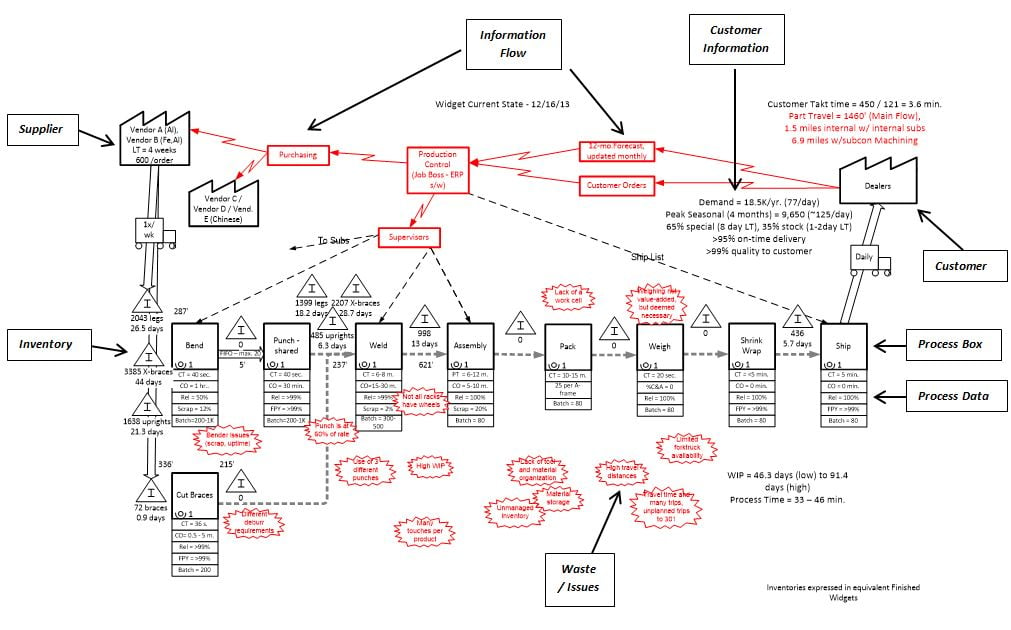I don’t claim to know everything about Value Stream Mapping (VSM). However, I have used VSM extensively over the past 15 years in many different industries and situations. I believe strongly in the value of the tool and want to share some of my experience with the intention of helping novice Continuous Improvement leaders head in the right direction with VSM.
What is Value Stream mapping?
Value Stream Mapping is the graphical representation of material and information flows through a process or service. Here is an example:
 Getting started in VSM can be daunting. Learning to See was written by Rother and Shook in 1998 and even though it is a rather simplistic book on VSM, it is a great starting point. It does a good job explaining the mechanics of creating a VSM. However, it does not answer many of the questions I’ve had to figure out through all the variations of VSM I’ve encountered. I hope to share some of what I’ve learned through this forum.
Getting started in VSM can be daunting. Learning to See was written by Rother and Shook in 1998 and even though it is a rather simplistic book on VSM, it is a great starting point. It does a good job explaining the mechanics of creating a VSM. However, it does not answer many of the questions I’ve had to figure out through all the variations of VSM I’ve encountered. I hope to share some of what I’ve learned through this forum.
What VSM is not: VSM is not observing and documenting an individual doing their work. A work study may result as an action from a VSM, but VSM is meant to span multiple functions / workstations.
What VSM shouldn’t be: A VSM should not be a team of one collecting data to fill in the blanks. While it may technically be a VSM, there is little benefit from this. The benefit comes from the collaboration, discussion, arguments, and sharing of ideas that can only come about in a team environment. VSM is the format that provides focus for this teamwork.
Why is it useful? Where does it fit in your Lean journey?
I have trouble imagining an organization not finding benefit in using VSM. It is a flexible, easy-to-use diagnostic tool that does a tremendous job of representing a process from start to finish. It’s visual, easy for most people to follow and understand, and promotes focused discussion, brainstorming and problem solving among a diverse group of participants. It has been used successfully in manufacturing, healthcare, banking / financial services, insurance, education, non-profits and many more industries.
When starting a lean journey, VSM should be one of the first activities taken. Prior to VSM or any other lean initiative, it is a good idea to set up a Lean Steering Committee or another guidance entity for management support and direction. This will help focus lean efforts on issues and opportunities that will have the most impact the business. The Lean Steering Committee will help direct which product families to focus on first, allocate resources, set scope & boundaries and will be a sounding board for suggestions resulting from the VSM.
VSM allows a team to see the big picture and focus on what will have most impact on the entire value stream. For example, without VSM, a business may focus on improving productivity of a non-bottleneck machine. A more impactful solution would be to reduce setup time on a primary piece of equipment which currently drives a very large batch size and excess inventory (and lead time) throughout the process.
If a business has limited lean exposure, it is a good idea to precede VSM with an introduction to lean processes via educational workshops like IMEC’s Lean Overview with Simulation, a book club, tours of other lean businesses, etc. At minimum, you want to have the VSM core team familiar with Value-Add, Non-Value-Add, 8 wastes, and the lean tools (SMED, 5S, Cellular, etc.).
You don’t have to start with VSM. 5S is also a good place to start a lean journey. It is easy for everyone to comprehend; it allows for mass participation and it’s a foundation for many other lean tools. It drives discipline (if it’s not already there), and the results are immediately noticeable and often dramatic. 5S and VSM can be done in parallel, but both should be tools used early in your lean journey. A VSM may help determine which areas to focus your 5S efforts on.
VSM itself does not improve anything; it is a diagnostic tool. The goal of VSM is to implement a Future State with less waste. VSM without implementation yields nothing. We need to use VSM to determine our roadmap and the projects / activities / policy changes that must be put in place to achieve our improvements. VSM is great for analyzing and planning, but it is simply that – putting a plan together. The benefit comes from being able to make changes through the understanding, vision, and consensus developed in the VSM.
Stay tuned for part 2 of the VSM blog series, coming tomorrow.
At the end of the series on Friday, you will receive a complimentary e-book, A Practical Guide to Value Stream Mapping. The e-book will go into further details about the basics of Value Stream Mapping, including:
- Why companies do VSM
- How VSM is different than Process Mapping
- The Difference between transactional / administrative VSM and manufacturing – focused VSM




